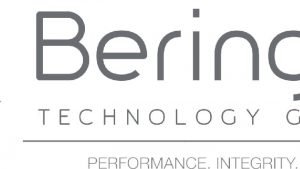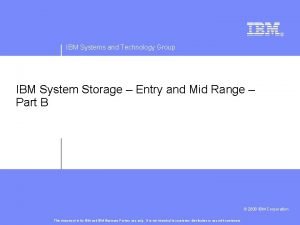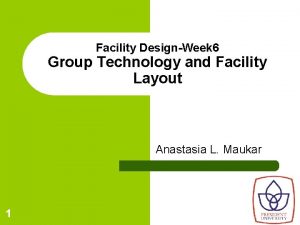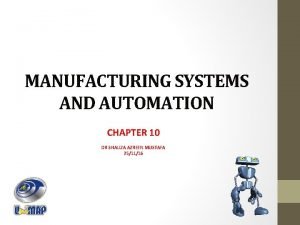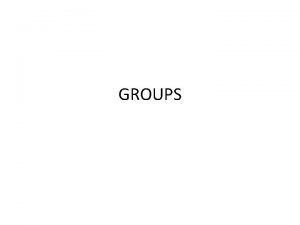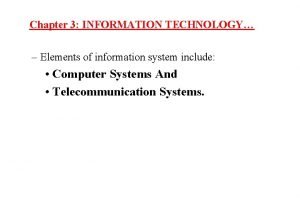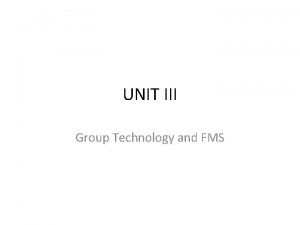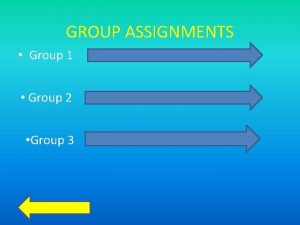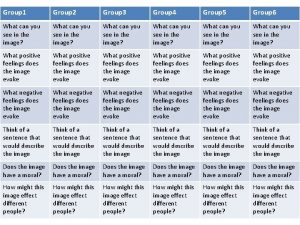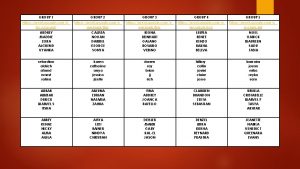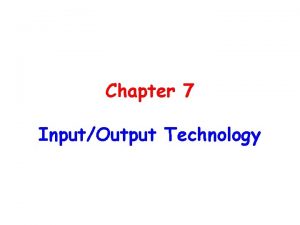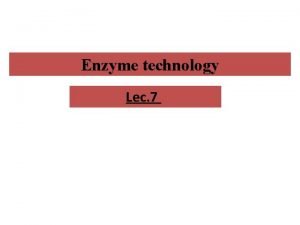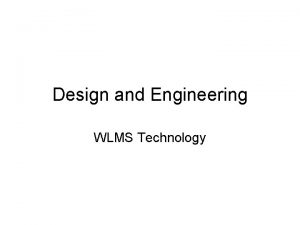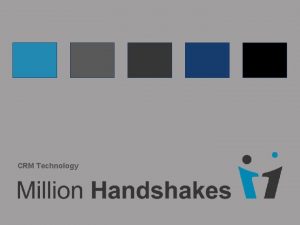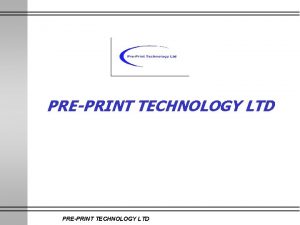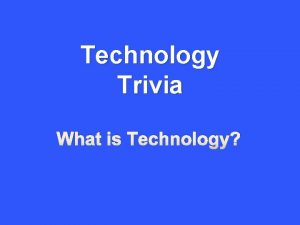GROUP TECHNOLOGY Chapter 10 GROUP TECHNOLOGY IS A


































- Slides: 34

GROUP TECHNOLOGY Chapter 10

GROUP TECHNOLOGY IS A MANUFACTURING TECHNIQUE AND PHILOSOPHY TO INCREASE PRODUCTION EFFICIENCY BY EXPLOITING THE “UNDERLYING SAMENESS” OF COMPONENT SHAPE, DIMENSIONS, PROCESS ROUTE, ETC.

• Group Technology is the realization that many problems are similar, and that by grouping similar problems, a single solution can be found to a set of problems thus saving time and effort. (Solaja 73) • First book formalize the concept: Mitrofanov, S. P. 1958, "The Scientific Principles of Group Technology"

Why Group Technology? • Average lot size decreasing • Part variety increasing • Increased variety of materials With diverse properties • Requirements for closer tolerances

HIGH FL EX PR VOLUME TRANSFER LINE SPECIAL SYSTEM OD UC T IBI LIT Y IO NC AP A CI TY FLEXIBLE MANUFACTURING SYSTEM MANUFACTURING Cells STD. AND GEN. MACHINERY LOW VARIETY HIGH

Everyday Examples 1. Fast food chains 2. Doctors, dentists and also manufacturing A FAMILY OF PARTS

Production Family

• Lack Of Common Database For Mfg. , Design. . . • Don’t “redesign the wheel” • Automated process planning • Database to drive the automated factory

Benefits Of Group Technology Reductions in Throughput time Set-up time Overdue orders Production floor space Raw material stocks In-process inventory Capital expenditures Tooling costs Engineering time and costs New parts design New shop drawings Total number of drawings Cont’d

Other Benefits Of Group Technology Easier to justify automation Standardization in design Data retrieval Easier, more standardized process plans Increases in quality

Gt affects most every operating and staff function. It is more than merely a technique, but a total Manufacturing philosophy. DATA PROCESSING DESIGN ENGINEERING MAINTENANCE INVENTORY TOOL ENGINEERING PLANNING ESTIMATING PURCHASING INDUSTRIAL RELATIONS ASSEMBLY QUALITY CONTROL MANAGEMENT MFG. ENGINEERING R&D COST ACCOUNTING SALES GT SHIPPING & RECEIVING

Three Techniques To Form Part Families 1. Tacit judgment or visual inspection • May use photos or part prints • Utilizes subjective judgment 2. Production Flow Analysis • Uses information contained on the route sheet (therefore only mfg. Info) • Parts grouped by required processing Cont’d

3. Classification And Coding • Codes geometry/design and mfg. Info about a component • Codes are alphanumeric strings • Easier to use for other analyses

Types Of Classification And Coding Systems GT coding can benefit many facets of the Firm and fall into one of 3 categories: 1. Systems based on part design Attributes 2. Systems based on part mfg. Attributes 3. Systems based on design and mfg. Attributes

Examples: Part Design Attributes Part Mfg. Attributes Basic external shape Basic internal shape Material Major processes Minor operations Fixtures needed Length/diameter ratio Surface finish Tolerances-----machine tool Operation sequence Major dimension Tooling Batch size

GT Code--a Sequence Of Numerical Digits Three major structures: 1. Monocode (or hierarchical structure) A code in which each digit amplifies the information given in the previous digit • Difficult to construct • Provides a deep analysis • Usually for permanent information cont’d

2. Polycode (Or Chain-type Structure) Each digit is independent of all others, presents information not dependent On previous ones • Easier to accommodate Change 3. Mixed Code Has some digits forming monocodes, but strings them together in the general Arrangement of a polycode

MAPPING FROM POPULATION SPACE TO CODE SPACE POPULATION SPACE H P CODE SPACE C

Hierarchical Structure H Ele ctr ica l 321 X 323 X r we Po UNF thread d ea th r No ad 3223 g re th 3222 C UN 3221 3232 in 322 X iv ce 3231 Re Mechanical Transmission yd 32 XX lic u a r 3233

Hybrid Structure Polycode Monocode Polycode

Reduction Of Mfg. Costs By Various Steps Of Group Technology Applications (Adapted From Ham 442) Not All Cost Savings Are Immediate. . . Improvements in Engineering Design Materials Management & Purchasing Benefits Production Control Benefits Manufacturing Engineering Benefits Tooling & Setup Benefits Management Benefits Overall Cost Reduction & Increased Productivity 0 6 12 18 24 Time (months) 36

• Proliferation Of Parts Selection of optical instrument parts in one company, Illustrating the similarity between certain components • Note: some of the above are almost the same

Conceptual design Design concept can be coded. Code is a rough model of the conceptual design. Coding (rough model) Retrieval existing designs Design archive Existing designs Design modification New Design Retrieve designs of similar shape or function and use them as the examples.

Technique: 1. Determine part and machine requirements 2. Numerically code each part Geometry (& size) Material Other specifications (tolerance, Surface finish) 3. Form a family of similar parts which use (Largely) the same set of machine tools 4. Lay out of each cell (a group of machine Tools) to make a family of parts 5. Design group tooling

Example: Thirteen parts with similar manufacturing Process requirements but different Design attributes

Functional Layouts Are Inefficient Drilling Milling Lathe L L M M D D Grinding L L L M M Assembly L A A Receiving and Shipping A A PROCESS-TYPE LAYOUT G G G

Group Technology Layout L L M D G A Receiving L L M M D G A G Shipping

Cellular Layout Department #2 D D Department #1 M I D I L Department #3 L L D M M I M

2 nd Digit main shape 0 2 3 Rotational 1 3 rd Digit rotational machining 5 th Digit 4 th Digit additional plane surface holes teeth & matching forming External shape element Internal shape element Machining of plane surfaces Other holes and teeth Main shape Rotational machining Machining of plane surfaces Other holes teeth and forming Main bore & rotational machining Machining of plane surfaces Other holes teeth and forming 4 5 6 7 8 9 Special Non-rotational Positions with a digit Form Code Main shape Special Main shape Supplimentary code Digit 6 7 8 9 Dimensions Material Original shape of raw materials Accuracy 1 st Digit part class Opitz coding and classification system. (Reprinted with permission from H. Opitz, A Classification System to Describe Workpieces, Pergamon Press. )

Typical Process Planning System Engineering drawing Process planner XXX Process planning system Code or other form of input Process Industrial engineer • Time standard • Operation instruction • Layout Part programmer APT Program APT Processor & post-processor Production planner • Scheduling • MPP

Process Planning “Process planning” is that function within a manufacturing Facility that establishes which machining processes and Parameters are to be used (as well as those machines capable Of performing these processes) to convert (machine) a piece Part from its initial form to a final form predetermined (usually by a design engineer) from an engineering drawing. (I. E. The preparation of the detailed work instructions to Produce a part) Process planning bridges design and manufacturing Bridge Design Manufacturing

Variant Process Planning Uses the similarity among components to retrieve existing process plans (which can be modified) Overview: Two Stages For VP Systems 1. Preparatory stage • Existing parts coded & classified (i. E. Gt is a prerequisite) • Part families organized • Standard plans developed • Databases created )Note: this stage is labor intensive) Cont’d

1. Preparatory Stage Of Variant Process Planning Part Drawing Coding Family One Standard Plan File Family Formation Process Plan )Indexed by Family Matrix)

2. Production Stage Of Variant Process Planning Coding Family Search Process Plan Editing Standard Plan Retrieval Standard Plan File
 Beringer technology group
Beringer technology group Row and column masking algorithm
Row and column masking algorithm Cx4-120 iops
Cx4-120 iops Ibm systems and technology group
Ibm systems and technology group Contoh group technology
Contoh group technology Encore technology group
Encore technology group Btg biomass technology group bv
Btg biomass technology group bv Berkeley law & technology group llp
Berkeley law & technology group llp Ibm systems and technology group
Ibm systems and technology group Group technology and cellular manufacturing
Group technology and cellular manufacturing Monocode and polycode
Monocode and polycode Group technology layout example
Group technology layout example Group technology
Group technology China titans energy technology group
China titans energy technology group Ibm systems and technology group
Ibm systems and technology group Deindividuation psychology definition
Deindividuation psychology definition Y = a(b)^x
Y = a(b)^x Anova within group and between group
Anova within group and between group Unsocial group example
Unsocial group example Imt group 2 specialties
Imt group 2 specialties Thermal stability of group 2 nitrates down the group
Thermal stability of group 2 nitrates down the group Amino group and carboxyl group
Amino group and carboxyl group Amino group and carboxyl group
Amino group and carboxyl group In group out group
In group out group Group yourselves
Group yourselves William graham sumner in group out group
William graham sumner in group out group Joining together group theory and group skills
Joining together group theory and group skills People who work with computers while doing business
People who work with computers while doing business Brake system diagnosis and repair
Brake system diagnosis and repair Chapter 80 brake system technology answers key
Chapter 80 brake system technology answers key Chapter 75 suspension system technology
Chapter 75 suspension system technology Emerging technology chapter 5
Emerging technology chapter 5 Chapter 5 it infrastructure and emerging technologies
Chapter 5 it infrastructure and emerging technologies Emerging technology chapter 5
Emerging technology chapter 5 Information technology chapter 3
Information technology chapter 3
